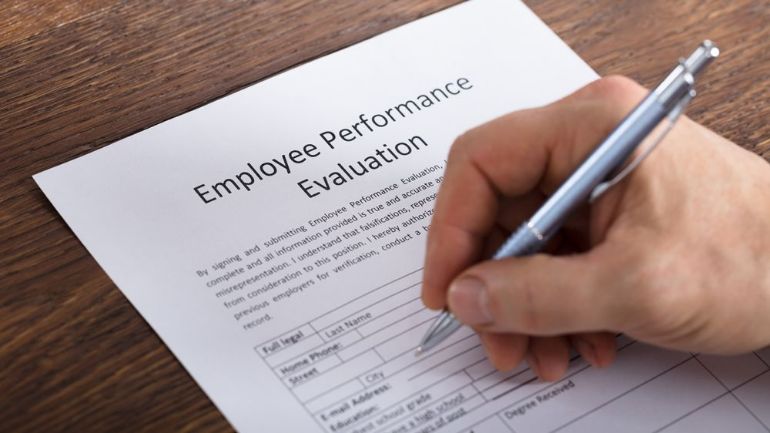

With everything restaurant managers have to juggle, keeping a close eye on employee performance is a task that can easily slip through the cracks.
Things might seem to be running smoothly. And then BAM!
A bad review online, a dip in sales, a kitchen accident, a higher turnover rate. Suddenly you’ve got a bigger problem – one that could have been solved with an employee performance assessment.
Enter the employee evaluation form. Paired with a performance review process, an employee evaluation form can help you keep track of your employees’ performance and make sure they’re meeting your gold-star standards.
In this article you’ll learn:
An employee evaluation form is a tool that managers and supervisors use to assess an employee’s performance at work over a certain period of time.
This form is used to facilitate performance reviews, which usually coincide with milestones in employment tenure (quarterly review, one year review, etc.). A typical employee evaluation form gauges employee performance in various aspects of the employee’s current role and assesses opportunities for improvement and professional development.

Conduct and manage regular employee evaluations with our free, fillable form.
Download NowEmployee evaluation forms are important in the restaurant industry because they help busy managers measure their employees’ performance and progress over time. And you know what they say: “If you can’t measure it, you can’t improve it.”
Formal records of employee accomplishments and challenges also come in handy when it’s time to give promotions. Or let staff go. You’ll want concrete paper trails to reference when making important decisions, so you can feel confident that your choices best support the business.
Plus, when new managers join your team, they can quickly learn about your staff by reviewing past employee evaluation records.
Even more, employee reviews and evaluation forms benefit staff members themselves by making it crystal clear what it takes to succeed in their roles. When employees can reflect on their performance, they can better understand where they excel and where they need to improve.

If you manage or operate a restaurant, you should use employee evaluation forms during every performance review. But how often should you conduct those reviews?
Let’s head back to the classroom for a quick analogy. Think of informal check-ins with your employees as quizzes, and performance reviews as exams. Quizzes (check-ins) help students (employees) gauge their understanding of the materials being tested, and help teachers (managers) understand how to prepare their students for the big exam (performance review) at the end of the semester.
Exams are major assessments that come once or twice during the semester. During an exam, students demonstrate their mastery of the subject to the teacher. If students pass, they’re ready to move on to a more advanced class. In the restaurant world, passing a performance review could lead to a promotion or a new opportunity and role.
While the corporate world recommends conducting performance assessments every six to twelve months, we recommend conducting them every three to six months to help decrease the restaurant industry’s high turnover rate. Schedule weekly or monthly one-on-one check-ins with your employees to help them stay engaged and on track between reviews.

You probably didn’t get into the restaurant industry because of your love of paperwork.
But we’re help to help.
This is an easy guide to using employee evaluation forms at your restaurant, helping you master this HR practice in no time. And that way, you can get back to the aspects of your job that you do love.
If you’re implementing a new employee evaluation form or performance review process, let your current team know about it as soon as possible, so they know what to expect. For new employees, share these guidelines with them during the onboarding process.
Will you review all employees at the same time or stagger reviews based on employee anniversaries? Whatever you choose, make the policy clear, so your employees aren’t surprised when they’re called in for a review. It’s also not a bad idea to give your employees a reminder a week or two before the review – they’ll appreciate the heads up.
Ever notice in school how it was easier to get a good grade on an assignment when your teacher gave you the grading rubric? When you understood how your teacher defined success, you knew where to focus your efforts. By showing your employees how they’ll be evaluated, they’ll understand what you’re looking for in their roles – outside of technical skills.
Now that you know how to lay the groundwork for expectations, here’s what you should do one week before a performance review:
Once your employee has filled out their self-evaluation, it’s your turn to complete your side as their manager.
Fill out the employee evaluation form before meeting – you don’t want to do this while the person is sitting in front of you. It’s inefficient, unprofessional, and, well, a little awkward.
Section by section, here’s how to fill out our free, printable employee evaluation form:
Pretty self-explanatory. Fill out the employee’s name and title, your name and title, the date of the evaluation, and the date of the employee’s last evaluation.
In this section, you’ll find a table. The columns on the left have various performance categories, such as technical skills, customer service, and communication. At the top of the other columns, there’s a handy rating scale that ranges from 1 to 5 (1 indicating poor performance, and 5 indicating exceptional performance). Check the rating that matches the employee’s performance in each category. Use the comment boxes below each category to elaborate on the rating.
Don’t forget to use the “overall performance” category to summarize your employee’s performance.
A few notes: We created this form to suit all roles within a restaurant. You may want to customize the form with categories that are applicable to specific roles at your restaurant or condense it into a shorter, single-page form.
BUT, keep in mind that even if a category doesn’t seem directly relevant to a role, it might apply to the employee you’re reviewing. For example, while “customer service” may not seem relevant to a back-of-house role, consider times when your line cook went above and beyond to make sure a customer got a dish just the way they liked it.

Conduct and manage regular employee evaluations with our free, fillable form.
Download NowFill out the boxes on strengths, weaknesses, and completion of past goals, while taking note of the employee’s self-evaluation.
Leave the last box (goals for the next review period) blank, so you and your employee can collaborate on these during the review. If they’re involved in setting the goals, they’re more likely to be involved in achieving them, too.
When you finish filling out the form, sign and date on the line. Your employee will sign their section during the performance review.
Worried about how the employee might react to their review? Share it with them a day or two before your meeting. This way they have time to work through any emotional reactions that might come up, making your meeting more productive.

Let the employee evaluation form guide the conversation during a performance review. But you don’t have to make it the only focus.
Go over the scores and then open it up for discussion. Make sure they know questions are welcome and encouraged.
After you’ve discussed your employee’s performance, look at the goals section. Discuss whether or not they’ve succeeded in achieving past goals (if applicable) and work together to create new goals for the next review period.
When the form is completely filled out and both parties have said their piece, have your employee sign the bottom to confirm the meeting took place.
While stellar employees are a manager’s dream, you’ll inevitably run into difficult conversations with employees who are underperforming. While negative performance reviews can be tough to handle, they’re critical to the success of your restaurant.
Negative reviews shouldn’t be a surprise. If an employee does something wrong on the job, they should be addressed immediately and have the opportunity to fix the situation. Don’t wait for a quarterly review to share constructive criticism.
That being said, poorly performing employees might still be upset by a negative review. If this happens, remain calm and avoid making the review overly personal. Remember: it’s business. Namely, yours.
If an employee has continued to perform poorly even after you’ve addressed them, the performance review is a good time to put the employee on probation or let them go.
There are a few things you want to do after an employee evaluation to maximize the results:
Reference these forms during your one-on-one check-ins to help employees stay on track of their goals. Then, when it’s time to offer promotions, raises, and incentives, you’ll have a clear guide to who’s performing well and, perhaps more importantly, who has grown the most – because when they grow, so does your business.

Conduct and manage regular employee evaluations with our free, fillable form.